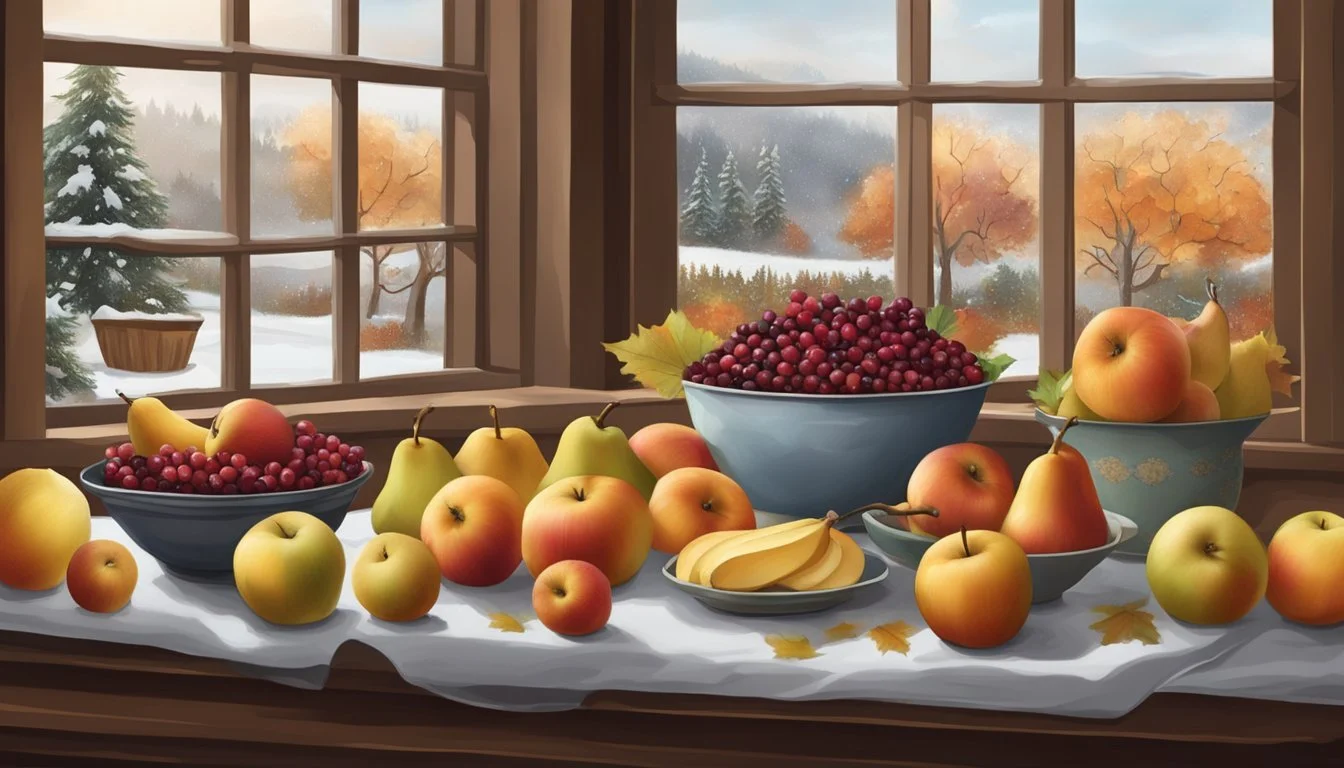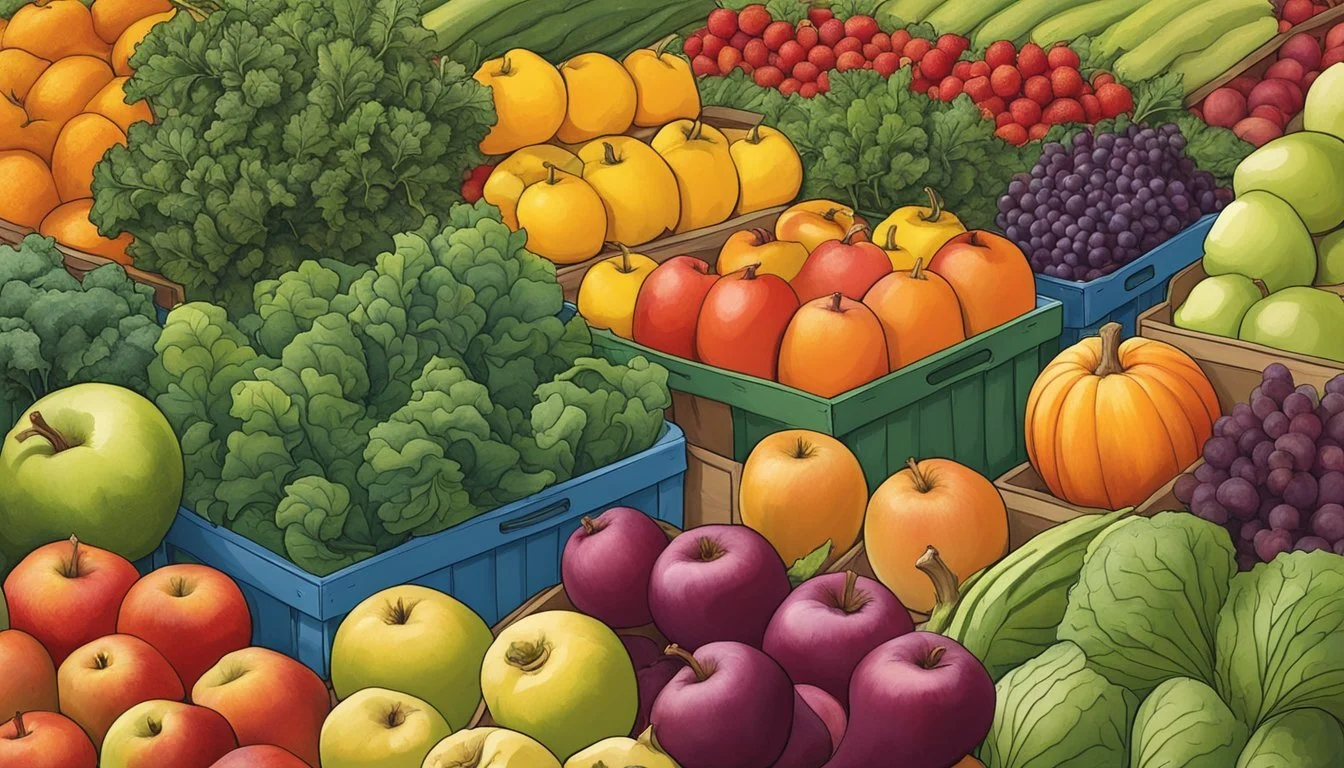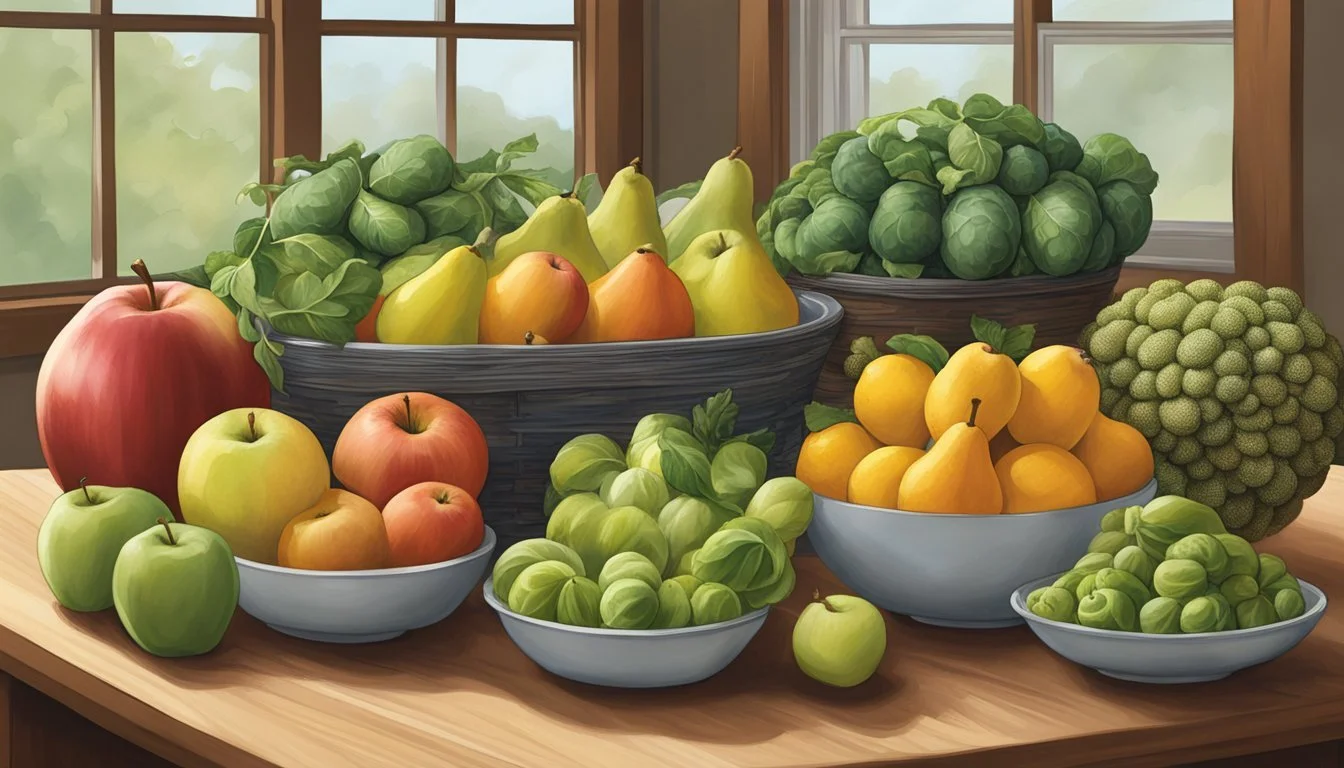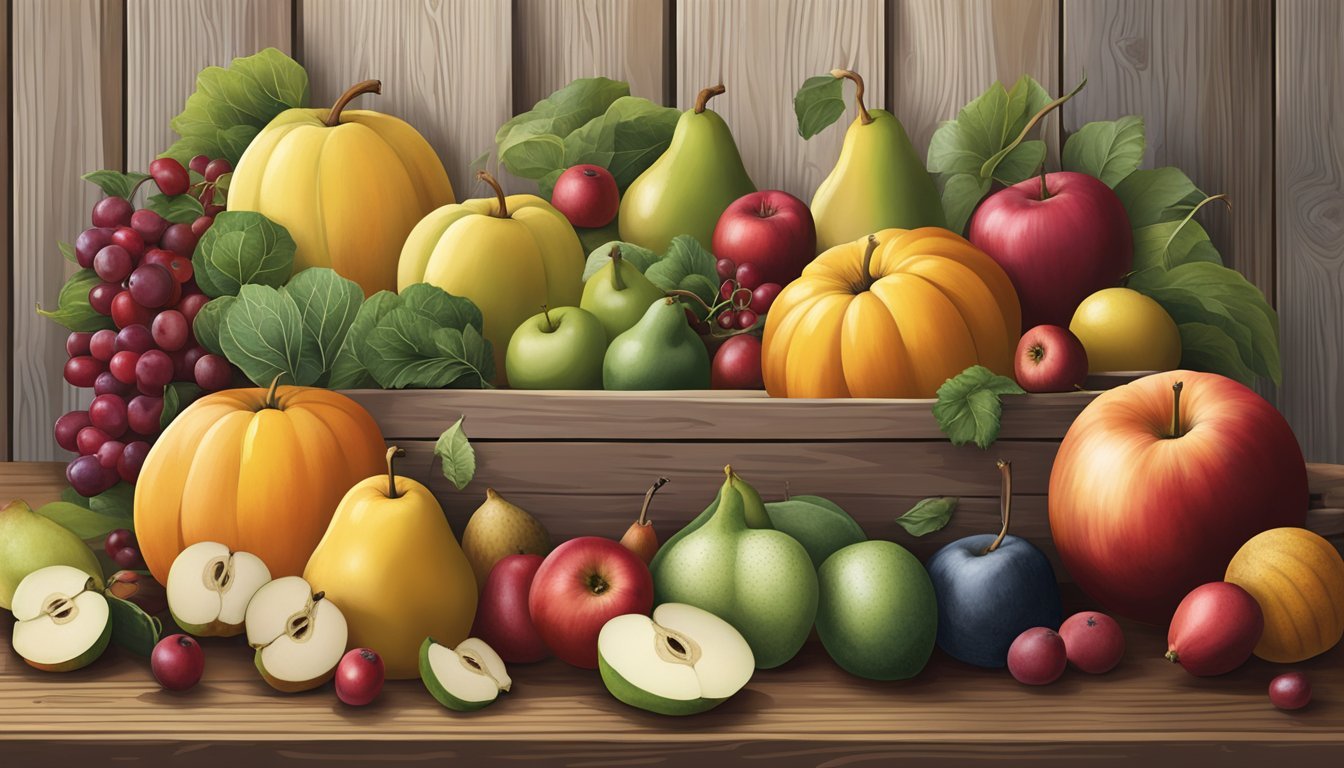Wisconsin Seasonal Fruit & Vegetables in December
Your Fresh Guide
This Article is Part of our Wisconsin Seasonal Fruit & Veg Calendar
In December, the chill of winter settles over Wisconsin, transforming the landscape into a frosty tableau. Yet, even as the cold grips the region, local farms and markets still offer an array of seasonal fruits (What wine goes well with fruit?) and vegetables that thrive in the colder months. Wisconsin's diverse agriculture means that despite the harsh weather, there is a bounty of produce available for those looking to incorporate fresh, local ingredients into their meals.
Seasonal fruits that one can find during this time include cranberries, which are a staple in Wisconsin and typically harvested in the fall but remain available fresh through December. This tart berry is synonymous with the holiday season and is a versatile ingredient in both sweet and savory dishes. While fruits are more limited, the focus shifts towards hearty vegetables capable of withstanding the colder climate.
Root vegetables and sturdy greens dominate the selection of seasonal produce. Residents can savor vegetables like potatoes, which are part of Wisconsin's significant crop production, and incorporate them into a variety of warm, comforting dishes. Alongside potatoes, various types of winter squash and hardy greens such as kale, which can survive well into the colder months, provide nutrition and flavor to winter meals. These vegetables are not only resilient but also lend themselves well to storage, ensuring a steady supply throughout the season.
Overview of Wisconsin's December Produce
In December, Wisconsin's agricultural landscape transitions fully into winter mode, with shortened daylight hours and cooler temperatures affecting the types of produce available.
Seasonal Highlights in December
Root Vegetables: A staple of the season, items such as carrots remain available, primarily from storage, as their harvest season ends in early December.
Greens: Chard and similar hearty greens often last through November, with some availability into December.
Dairy and Pantry Staples: The state's year-round offerings, including cheese, milk, and dry beans, continue to be staple products.
Understanding Wisconsin's Winter Growing Conditions
Due to its latitude and continental climate, Wisconsin experiences cold winters. These conditions significantly reduce the types of cold-hardy crops that can survive, and most fresh field-farming pauses until spring. However, the storage of root crops and use of greenhouses or hoop houses may provide some fresh produce options.
Benefits of Consuming Seasonal Produce
Consuming seasonal produce in Wisconsin contributes to a sustainable food system by reducing transportation emissions and supporting the local economy. Seasonal foods are often fresher, thus potentially offering better nutrition and flavor.
Fruits Available in December
December in Wisconsin brings a limited but distinctive variety of fruits, primarily consisting of storage orchard fruits and imported citrus. Consumers continue to enjoy the late harvests and imported selections that are available during this chilly month.
Common Wisconsin Orchard Fruits
Wisconsin orchards typically offer:
Apples: Various apple varieties, including the late-season Envy™, are obtainable through December. This apple is praised for its sweet and complex flavor.
Pears: While their peak season concludes in late autumn, some varieties are still accessible in early winter from cold storage.
Cranberries: As a native fruit, cranberries have been harvested in the fall and remain on sale through December, supplying tart flavors and festive colors for the season.
Imported Citrus Fruits in the Market
The arrival of imported citrus fruits in Wisconsin markets provides a refreshing contrast to the wintery weather:
Oranges: A staple in the citrus category, oranges are available in markets, offering a vibrant taste and abundant vitamin C.
Clementines and Mandarin Oranges: Small, sweet, and easy to peel, these fruits are favorites during the holiday season, often found in grocery stores and markets.
Other Citrus: A range of other citrus fruits can also be found, providing variety and a tropical taste to Wisconsin's winter fruit selection.
December's Vegetable Harvest
In December, Wisconsin's cold climate presents an ideal environment for the growth and harvesting of a variety of vegetables, especially hardy root crops and nutritious greens. Here is a focused look at the types of vegetables available during this winter month.
Root Vegetables and Tubers
Root vegetables and tubers are available in abundance in December, having matured over the autumn months. They store well and can be used in a myriad of comforting winter dishes. Notable examples include:
Sweet potatoes: Rich in vitamins and flavor, they are a staple for winter cooking.
Beets (how long do beets last?): Known for their deep red color and earthy taste, they can be roasted or pickled.
Carrots: These are harvested throughout the month and retain their freshness when stored properly.
Parsnips: A less common root with a sweet, nutty flavor, perfect for roasts and stews.
Turnips: Valued for their versatility in both cooking and baking.
Root vegetables in Wisconsin not only survive the colder temperatures but actually become sweeter post the first frost, as the plants convert starches into sugars.
Cruciferous Vegetables and Winter Greens
Cruciferous vegetables and winter greens thrive well into December. These vegetables are well-suited to the drop in temperature, and some even gain in flavor after a frost. The selections include:
Kale: Hardy and rich in nutrients, it is a green that continues to grow in winter.
Brussels sprouts (how long do brussels sprouts last?): They peak this month, becoming sweeter after a hard frost.
Colder weather and winter frost also help reduce the inherent bitterness in these vegetables, making them more palatable. In dishes, they provide both bold flavors and nutritional benefits.
Farmers Market and Local Availability
Even in the cold month of December, Wisconsin shoppers have access to locally-grown produce. Through farmers markets and CSA programs, residents can enjoy the fruits and labor of local agriculture.
Finding Local Produce in Winter
Wisconsin farmers markets adapt to the colder months, enabling consumers to find local produce. Many markets move indoors during winter, providing a venue for consumers to obtain seasonal vegetables such as beets, cabbage, carrots, garlic, onions, parsnips, potatoes, rutabagas, and spinach. These items are often available because they can be stored well after harvest, keeping the local produce supply steady even out of the growing season.
Community Supported Agriculture (CSA) Programs
CSA programs offer a direct way for consumers to buy local produce during the winter. Participants receive regular deliveries or pick-ups of seasonal produce, which may include storage vegetables and greens from hoop houses. CSA programs help sustain local agriculture efforts and allow consumers to support and connect with area farmers throughout the year.
Holiday Season and Produce Selection
During the holiday season in Wisconsin, residents have the opportunity to incorporate fresh, local produce into their festive dishes and gift-giving traditions. The Wisconsin winter may be cold, but the selection of seasonal produce provides a warm addition to any holiday table.
Produce for Festive Dishes
In December, Wisconsin's harvest yields a variety of produce that can be used to create sweet and savory holiday dishes. Cranberries, a staple in Wisconsin agriculture, are readily available and perfect for making cranberry sauce, relishes, and festive desserts. While pomegranates are not native to Wisconsin, they are a popular imported fruit during this time and can add a sweet-tart flavor and a pop of color to salads and drinks.
Herbs and hearty vegetables are also in season. Local produce such as leeks and stored root vegetables can be used in savory holiday recipes, such as roasted dishes (What wine goes well with roasted dishes?) and warm soups which are perfect for the chilly weather.
Gifts from the Wisconsin Harvest
Wisconsin's seasonal produce can also be transformed into unique gifts that celebrate the local flavors. Cranberries from local cranberry farms can be given as fresh fruit, made into homemade sauces, or dried for a healthy snack. Wisconsin is known for its cranberry bogs and is a leading producer of the fruit, making it a genuine and thoughtful gift.
Additionally, for those with a sweet tooth, gift baskets filled with clementines and tangerines offer a vibrant and juicy treat. These citrus fruits are common during the holiday season and are appreciated for their sweet flavor and ease of peeling. Although not grown in Wisconsin due to the climate, they are often enjoyed during this time and included in holiday gift baskets.
Utilizing December Produce in Meals
In December, Wisconsin's seasonal produce offers robust flavors and versatility in the kitchen, with root vegetables and hearty greens taking center stage in warming recipes and preservation techniques ensuring extended enjoyment.
Winter Recipes and Cooking Methods
Root Vegetables: They excel in roasted dishes which caramelize their natural sugars for enhanced flavor. Popular recipes include roasted beet salads, turnip gratins, and carrot soups.
Soups & Casseroles: These dishes are ideal for incorporating a variety of vegetables such as potatoes, carrots, and cruciferous greens. Kale can be stirred into potato soup for added nutrients, while Brussels sprouts might be featured in a creamy casserole.
Seasonal Fruits: Cranberries, native to Wisconsin, can be used in sauces, baked goods, and as a tart accent in salads. They pair well with sweet and savory dishes, adding a punch of flavor and color.
Preservation and Storage Tips for Winter Produce
Cranberries: Best kept in a cool, dry place, and can be frozen for long-term storage. One can rinse and spread them on a baking sheet to freeze before transferring to a freezer bag.
Root Vegetables:
Vegetable Storage Method Potatoes Store in a cool, dark, well-ventilated place to prevent sprouting. Carrots Keep in the crisper drawer of the refrigerator to maintain crunchiness. Beets Remove greens and store in a plastic bag in the refrigerator.
Freezing: Greens such as kale and Brussels sprouts can be blanched and frozen for future use in cooked dishes.
By employing these methods, one can maximize the lifespan and flavor of Wisconsin's December produce.
Health Benefits and Nutritional Information
In December, the seasonal fruits and vegetables of Wisconsin offer not only a flavorful addition to meals but also a wealth of health benefits due to their high nutrient content. The consumption of these foods is particularly advantageous during the colder months, as they can provide necessary vitamins and minerals to support a healthy immune system and overall wellness.
Highlighting Nutrient-rich Winter Produce
Carrots, often "frost kissed," are sweet and abundant in the winter. They provide beta-carotene, which the body converts to vitamin A, essential for healthy eyes and skin. Cranberries, another winter crop, are packed with antioxidants and vitamin C, which are known for their immune-boosting properties.
Potatoes, a staple root vegetable, are a good source of vitamin C and potassium. When consumed with their skins, they provide valuable dietary fiber. Pumpkins stand out for their versatility and richness in vitamins A and C, fiber, and potassium, offering multiple health benefits like supporting immune function and reducing inflammation.
Citrus fruits like oranges and grapefruits become available during the winter months and deliver a high dose of vitamin C, vital for immune health.
Dietary Considerations During Winter Months
During the colder months, it is important to consume a variety of seasonal produce to ensure a balanced intake of nutrients. Wisconsin's winter produce can contribute significantly to fulfilling these dietary needs.
For individuals seeking foods low in calories but high in fiber and nutrients, winter greens such as spinach and kale are excellent options. These greens are not only versatile in their culinary uses but also rich in vitamins A, C, K, and minerals like iron and calcium.
Eating raw fruits and vegetables can maximize their nutritional value, as cooking may lead to the loss of some vitamins. However, it's also beneficial to incorporate cooked produce into one's diet to enjoy a diversity of textures and flavors, which may enhance overall dietary satisfaction and adherence.






